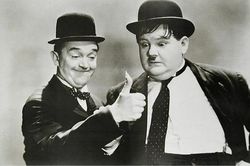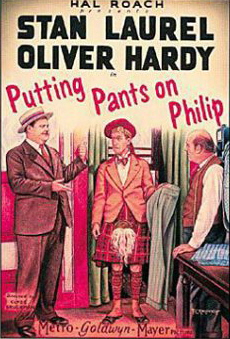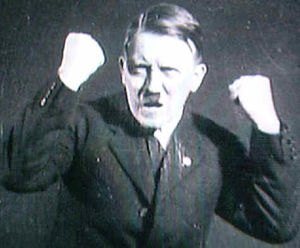Laurel and Hardy

“Chaos, illuminated by flashes of lightning. And funny hats.”
– Oscar Wilde on Laurel and Hardy
Laurel and Hardy were a transatlantic comedy phenomenon which took the world by storm in the early 20th Century with hits such as "On The Trail Of The Lonesome Pine"; "Why Don't You Be More Careful With My Nether-Regions?"; "Here's Another Fine Mess You've Gotten Me Into"; and "D'ooooh!" (later covered by Homer Simpson). The group comprised of Sir Stan Laurel (the cute one) and Lord Oliver of Hardy (the funny fat one).
Originally rising to fame during the silent era, where comedians were to be seen and not heard, Stan and Ollie brought light to the Great Depression by producing films upon films involving a fat bloke getting kicked up the arse. They quickly captured the public's imagination - in particular that of teenage girls who would go wild for the "T'riffic Two".
Formation and rise to fame[edit | edit source]
Laurel and Hardy met at the Woolton village fete in 1920, where Laurel - a struggling British comedian - was performing as a Charlie Chaplin impersonator. His act consisted of swinging his leg in the air whilst wearing a silly hat, but had little success. Laurel was about to leave the stage when, in a last ditch effort to gain a smirk, he swung his leg a final time accidentally connecting with the posterior of Hardy - a visiting Yank - as he bent down to smell some flowers. Hardy turned to the gathered audience with a pained expression, then to Laurel, and declared "Why don't you be more careful?". The crowd erupted with laughter and Hal Roach, who was in the audience, immediately signed them up for 5,000 silent short films.
A team of writers - including Laurel - were signed up to create these films. Initially ambitious, the group soon realised all they needed to do was follow a simple formula, illustrated here in 1929's The Bacon Grabbers:
| “ | Step 1: Stan and Ollie have to serve a summands
Step 2: Someone kicks Ollie up the arse Step 3: The culprit runs away Repeat as necessary |
” |
This simplistic formula proved to be a massive success and was repeated again and again, such as in 1932s The Music Box:
| “ | Step 1: Stan and Ollie have to push a piano up some stairs
Step 2: Someone kicks Ollie up the arse Step 3: The piano falls down the stairs Repeat as necessary |
” |
Backlash and change in style[edit | edit source]
They quickly overtook their contemporaries by being more conventional than Buster Keaton, more numerous than Harold Lloyd and funnier than Charlie Chaplin. In fact, the duo had a well publicised feud with Chaplin which reached a head when Hardy famously told an interviewer he hoped Chaplin "died of AIDS". This was not assisted by Laurel's ascertion that the two were "bigger than Hitler" (in 1932 people still thought Hitler was quite nice).
A backlash set in, with Ku Klux Klan members holding protests and burning Derby hats in the streets. It appeared that their career would not survive. However, rather than bow to public pressure, they began to experiment with their format.
Though their arse-kicking routine served them well, as their careers progressed they began to push the boundaries of slapstick - with the help of mind-expanding moonshine - to strange and exciting new places. Like kicking the fat bloke in the shin, and tweaking his nose.
Films such as Sons of the Desert (1933) and Way Out West (1937) displayed more dynamic and exaggerated physical violence, intricate plots and displayed Laurel's growing interest in Indian culture. One film, Thicker Than Water (1935), even included a fifteen minute instrumental collage called Fine Mess #9.
Though some fans felt alienated by this change, Laurel and Hardy's work became critically acclaimed and heavily influenced the work of slapstick comics The Three Stooges; The Marx Brothers; and Noel and Liam Gallagher.
Break-up[edit | edit source]
However, soon tensions between the comedians began to mount. Hardy entered a relationship with a domineering Alabamian conceptual novelist, Harper Lee. Her controversial attitudes influenced Hardy, who in turn irritated Laurel by insisting that their films should be a commentary on Civil Rights issues in America. Laurel thought this would get in the way of all the arse kicking.
The final straw came in 1940 when Laurel entered his dressing room only to bump into Hardy. The two stumbled about in a comical fashion, and their hats fell on the floor. Hardy was annoyed with Laurel and instructed him to pick up the hats. Laurel acquiesced but when the hats were back upon their heads, Hardy noticed that Laurel's was too big. Indeed, he was correct: Laurel had mixed up the hats. Hardy threw Laurel's hat on the floor in anger, Laurel copying him. Hardy, now furious, instructed Laurel to pick up the hats once more. But, alas, Laurel once more mixed up the hats and Hardy - having berated Laurel for his stupidity - stormed out of the room, leaving Laurel in floods of tears.
Hardy marched off of the film set, too proud to admit that he knew full well Laurel had mixed up the hats a third time and the one he was wearing was comically small.
Thus ended one of the finest double acts in cinema history.
Solo careers[edit | edit source]
Following the collapse of the act, Laurel and Hardy went on to forge solo careers which had varying degrees of success, never quite achieving the success of their work together.
Laurel remained in the comedy world, forming a new double act with Charlie Chaplin, burying their differences and forming the worlds first super group. However, despite the prestige of the pair, the duo failed to capture their former glory. Critically maligned, their standing in the comedy world meant that they maintained their commercial success, most notable their hits "Mull of Fat Bloke's Arse" and "Simply Having A Wonderful Time Kicking a Fat Bloke Up The Arse".
Hardy, on the other hand, took an entirely different and much more controversial career route. Having dropped much of his weight through and intensive routine of Jazzercise and left Lee to take up a new and mysterious life in Germany. Only one photograph of Hardy in this era remains, but it belies a strange question as to Hardy's actions during this "lost weekend".
As suddenly as he had vanished, Hardy re-emerged in Los Angeles 1947 but shunned the lime-light. Laurel refused to comment on his partner's odd behaviour. Though rumours circulated of a reunion, the two did not regain contact with one another. Laurel continued his series of ever-decreasing returns with Chaplin, and Hardy spent much of his time visiting South America to see a Mr Ron Vippenhoff, Randolph Hess and Herbert Goering.
However, as time progressed Laurel and Hardy re-built and amicable relationship, though this was short-lived and the reunion film never materialised. Their final public appearance together was on the cover of The Beatles' Sgt Pepper's Lonely Hearts Club Band though the fact that they insisted Richard Lindner and George Bernard Shaw be stood between them tells of the tension which had re-established itself by the time of Hardy's death - by suicide pill - in 1970.
Laurel lived on until his own death in 1977, a boon considering he has previously died in 1965.
Quotes[edit | edit source]
"Ahhhhhhhhh oooooooohhhhhhh" (crash)(Sons of the Desert) "Oooooooooooooh ahhhhh ahhhhh ahhhhhh (crash)(Trail of the Lonesome Pine) "Why don't you do something to help me ?" (Sawmill capers)
Related Businesses[edit | edit source]
Laurel and Hardy were one of the first superstar acts to parlay their fame into many successful business enterprises. Their "Slapdash" line of bowler hats were being worn by over a million teens worldwide in 1922. This helped launch their popular HardLaur clothing line which included Hardy-sized t-shirts with pre-sweated armpits and bow-ties for shoes.
By 1925, HardLaur was marketing over 39 products including cereals that were hard to pour into your bowl, the iGramoPhone portable/automobile 78 RPM record player, books on masking tape and piano moving equipment. They pioneered the "reality game show", when they hosted 71 performances of "Survivor: Thin and Fat Edition" at Radio City Music Hall in 1926. They were able to feature many of their products within the game, such as when contestants had to clean their part of the stage using their "Fine Mess" brand of vacuum cleaners.
The combined earnings for all their business ventures were well over $5 million, which is worth nearly $6 million in today's money. Unfortunately, after talkies were introduced (motion pictures that were so boring that the audiences had conversations during the movie), people realized how silly their products were and HardLaur quickly went out of business.


